There’s an unmistakable enchantment that envelops every dish of the best moroccan food. The moment aromatic spices dance in hot olive oil and release their tantalizing fragrances, you can sense you’ve embarked on an unforgettable culinary journey. This blog post will unveil the complexities and comforting warmth behind each beloved staple, from the most iconic chicken tagine to lesser-known local treasures. Prepare your senses for an exploration of ancient recipes, as we discover the succulent flavors that define real gastronomic magic.
From a perfectly stewed chicken tagine recipe to the hearty nuances of a slow-cooked moroccan chicken tagine, each dish tells a story of culinary heritage passed down through generations. Consider this guide your ticket to traverse spice markets, bustling kitchens, and family gatherings, all teeming with sumptuous discoveries. Whether you’re a first-time taster or a seasoned enthusiast, you’ll soon see why Moroccan cuisine stands out as one of the world’s most exhilarating. Let us dive in and feast on centuries of timeless tradition.
Table of Contents
Chicken Tagine
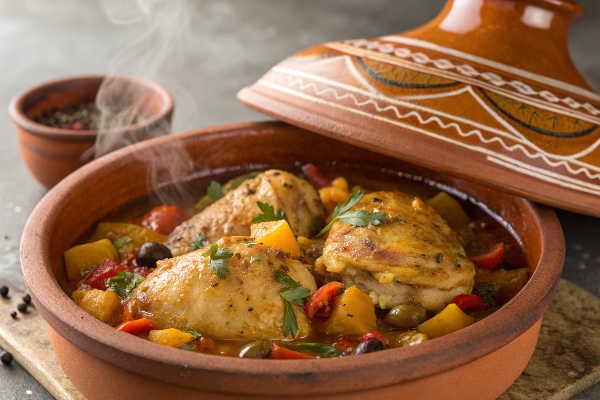
In my family, Chicken Tagine is a symbol of shared moments and familial warmth. I still recall my grandmother’s gentle hands layering the pot with succulent pieces of tender chicken, perfectly seasoned with saffron, turmeric, and ginger. The aroma would waft through the courtyard, calling everyone to gather around the low dining table. That first bite, with meat falling off the bone, taught me how a single dish can embody heritage and comfort. It’s no wonder this recipe is hailed as a moroccan chicken tagine masterpiece.
What sets Chicken Tagine apart from other entrées in the realm of best moroccan food is the slow-cooking method that locks in moisture and flavor. The conical pot—tagine—encourages steam to swirl and infuse the chicken with a delicate, spiced essence. Serve it with soft bread or fluffy couscous to soak up the sumptuous sauce. It’s an enchanting interplay of citrusy brightness (often from preserved lemons) and sweet, briny olives, making every mouthful a melodic contrast between tender meat and fragrant gravy.
Level of Preparation: Moderate
Ingredients & Method: Chicken pieces, preserved lemons, olives, saffron, turmeric, ginger. Sear the chicken, add spices and aromatics, then slow-cook under a tagine lid.
Average Calories: ~400 per serving
Techniques: Slow braising, layering flavors
Budget: Moderate
Lamb Tagine with Prunes

Lamb Tagine with Prunes is a treasure within the tapestry of moroccan food, evoking the rich, velvety aura of a lavish family feast. I remember my aunt’s bustling kitchen where succulent lamb simmered patiently, its juices merging with plump prunes, cinnamon, and honey until it became a mouthwatering delight. The sweet-meets-savory allure offered an almost regal experience, transporting me to North African palaces and spirited gatherings. It’s a comfort-laden dish that beckons you to savor every single spoonful.
What makes this Tagine shine among the best moroccan food is its artful layering of flavors—tender lamb enveloped in the sweetness of dried fruit and the earthiness of aromatic spices. Though it may differ from a classic chicken tagine, the slow cooking process works similarly to yield melt-in-your-mouth textures. A sprinkling of toasted almonds adds a subtle crunch, elevating each bite to gourmet heights. Pair it with steamed couscous or fresh bread to fully appreciate the luscious sauce.
Level of Preparation: Moderate
Ingredients & Method: Lamb shoulder, prunes, onions, cinnamon, honey, and stock. Brown the meat, add aromatics, and simmer slowly until fork-tender.
Average Calories: ~500 per serving
Techniques: Caramelizing onions, slow stew
Budget: Moderate-High
Vegetable Tagine
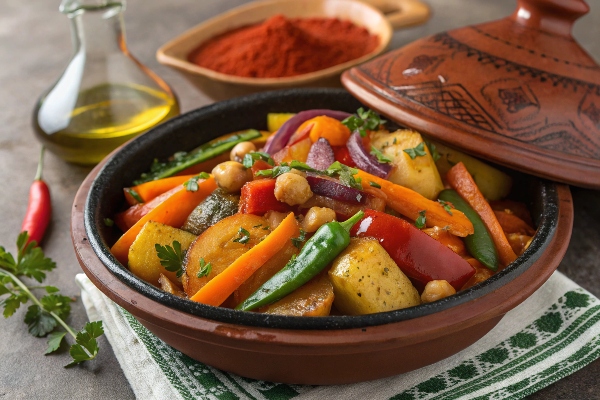
Vegetable Tagine is a comforting vegetarian haven amidst the bold flavors of moroccan food. My earliest encounter was in a bustling Marrakesh eatery, where colorful vegetables—carrots, zucchini, and potatoes—were nestled beneath a fragrant sauce that sparkled with paprika and cumin. I was utterly enchanted by how something so simple could exude such depth, proving that plant-based dishes can be every bit as indulgent as their meaty counterparts. It remains a must-try for anyone seeking wholesome nourishment with a touch of North African flair.
What elevates this vegetable tagine beyond mere stew is the synergy between fresh produce and the aromatic medley of herbs. Though it doesn’t feature meat like a moroccan chicken tagine, it retains the same slow-cooked tenderness—an homage to centuries of tradition. The vegetables soak in a savory broth spiked with ginger, garlic, and preserved lemons, resulting in a balanced harmony of earthy, sweet, and tangy notes. Enjoy it alongside steaming couscous or a crusty loaf to absorb every last drop of goodness.
Level of Preparation: Easy
Ingredients & Method: Carrots, zucchini, potatoes, chickpeas, paprika, cumin, broth. Arrange chopped veggies in a tagine, add spices, and simmer gently.
Average Calories: ~300 per serving
Techniques: Layering, slow cooking
Budget: Low
Moroccan Couscous
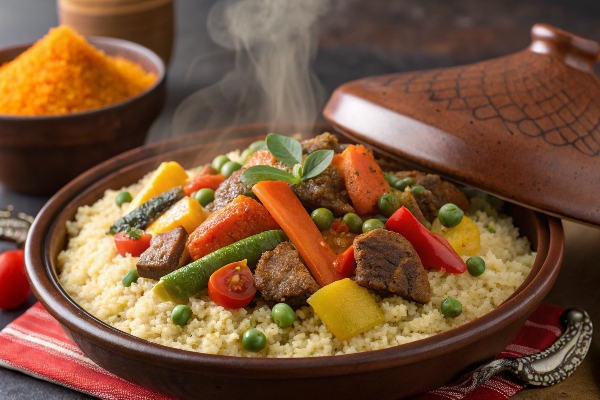
Moroccan Couscous is the vibrant heart of any moroccan food celebration. I vividly recall gatherings where large platters of fluffy semolina grains were topped with succulent meats, colorful vegetables, and a cascade of fragrant broth. It was the centerpiece, encouraging family and friends to lean in, share stories, and relish the communal spirit. The gentle couscous pearls seemed to soak up every bit of flavor, transforming into a heavenly medley that still reminds me of the warmth and laughter of home.
This dish stands among the best moroccan food options for its adaptability—you can pair it with chicken tagine, grilled vegetables, or spiced lamb. The key lies in steaming the grains multiple times, ensuring a light, airy texture that practically melts in your mouth. Traditionally served on Fridays, Moroccan Couscous symbolizes unity and gratitude, making it an emblem of cultural identity. Garnish with fresh herbs, plump raisins, or toasted almonds to add layers of delightful texture and complexity.
Level of Preparation: Moderate
Ingredients & Method: Fine couscous grains, stock, olive oil, mixed vegetables or meat. Steam couscous over simmering broth, fluff, and repeat.
Average Calories: ~350 per serving
Techniques: Repeated steaming, gentle fluffing
Budget: Moderate
Pastilla
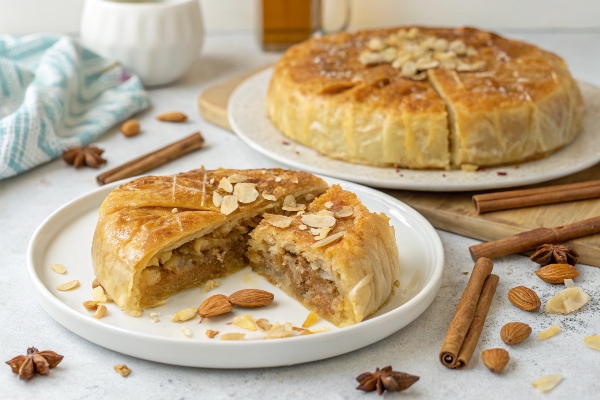
Pastilla, a flaky sweet-and-savory pie, often appears at weddings and festive occasions, showcasing one of the most elaborate preparations in the best moroccan food repertoire. The first time I tasted it, I was astonished by the marriage of delicate phyllo pastry, spiced poultry, and a dusting of cinnamon-sugar on top. The crunch gave way to a succulent filling, melding sweet almonds with savory meat in a way that felt almost decadent. Each bite was a revelation, whispering stories of royal banquets and jubilant ceremonies.
Although Pastilla is distinct from a chicken tagine recipe, it still relies on the same mastery of spiced moroccan chicken that defines traditional dishes. Layers of thin pastry envelope a fragrant, shredded chicken mixture, binding it together with scrambled eggs and almonds. This unique contrast of textures and flavors is both unexpected and enchanting. If you’re looking to impress dinner guests or simply treat yourself, Pastilla is a luxurious indulgence that captures the full spectrum of Morocco’s culinary artistry.
Level of Preparation: Hard
Ingredients & Method: Phyllo dough, spiced chicken, eggs, almonds, cinnamon. Cook chicken with spices, shred, combine with eggs and almonds, then layer in phyllo.
Average Calories: ~550 per slice
Techniques: Layering, balancing sweet and savory
Budget: Moderate-High
Harira
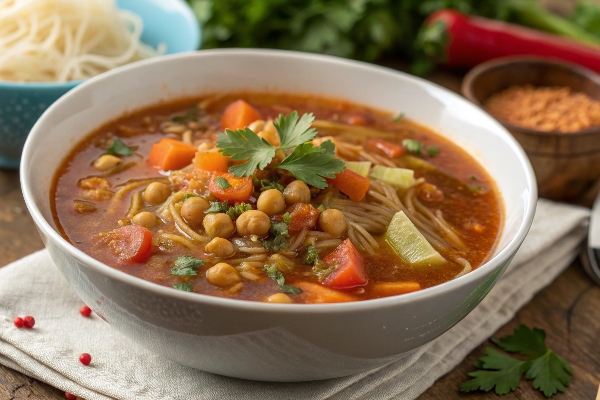
Harira is a soulful, tomato-based soup that epitomizes comfort within moroccan food. My memory of this dish is inseparable from the lively conversations and communal spirit of Ramadan evenings, where a warm bowl of Harira often signals the end of fasting. Each spoonful delivers lentils, chickpeas, and tender morsels of meat, enveloped by a delicate yet robust blend of spices. Even as a child, I felt nurtured by this soup’s gentle warmth, as if it carried the reassurance of home in every drop.
As one of the best moroccan food staples, Harira is versatile enough to shine at any mealtime, not just during special occasions. Though it differs from heavier meals like chicken tagine, its hearty ingredients leave you feeling blissfully satisfied. Aromas of coriander, celery, and turmeric intertwine, forming a comforting broth that’s as wholesome as it is flavorful. Often finished with a squeeze of lemon and a drizzle of olive oil, this soup bridges nourishment and tradition in a single, steaming bowl.
Level of Preparation: Moderate
Ingredients & Method: Tomatoes, lentils, chickpeas, meat, onions, celery, aromatic spices. Simmer until tender and slightly thickened.
Average Calories: ~300 per bowl
Techniques: Layering flavors, controlled simmer
Budget: Low-Moderate
Zaalouk
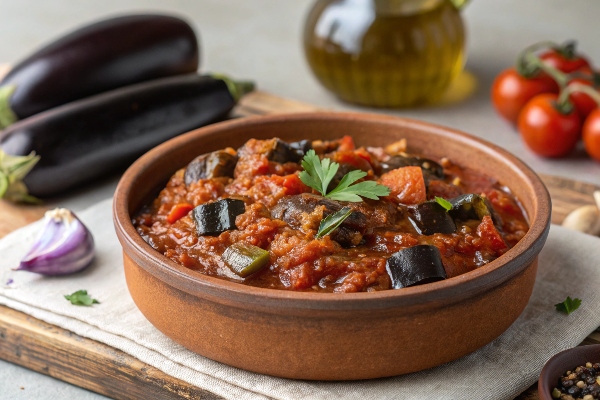
Zaalouk is a velvety eggplant and tomato dip that adds vibrant color and bold flavor to any spread of best moroccan food. My discovery of Zaalouk came at a traditional family lunch, where it was served alongside warm bread and fresh salads. Its smoky undertones and creamy texture captivated me from the first bite, offering a satisfying contrast to richer dishes. I’ve come to treasure it as the ultimate appetizer—straightforward yet sublime, it embodies Morocco’s penchant for turning simple vegetables into savory delights.
Though it’s far lighter than hearty fare like moroccan chicken or a well-spiced vegetable tagine, Zaalouk carries a distinctive punch of flavor thanks to garlic, cumin, and paprika. Eggplant is roasted or charred to draw out a smoky essence, then simmered with tomatoes until the mixture reaches a thick, dip-like consistency. A drizzle of high-quality olive oil on top completes the mosaic of tastes. Scoop it up with bread or crackers, and you’ll understand why it holds a special place on Moroccan tables.
Level of Preparation: Easy
Ingredients & Method: Eggplants, tomatoes, garlic, olive oil, spices. Roast or sauté eggplants, then cook with tomatoes and seasonings until smooth.
Average Calories: ~150 per serving
Techniques: Charring, slow simmer
Budget: Low
Taktouka

Taktouka is another beloved salad in moroccan food culture, striking a refreshing balance between roasted green peppers, ripe tomatoes, and an array of aromatic spices. I first tasted it in a bustling open-air market, where its bright colors instantly caught my eye. With each spoonful, I felt the sun-kissed produce come to life, tangling sweet, smoky, and tangy flavors. Taktouka’s playful nature reminds me that Moroccan cuisine can be light and invigorating, even as it delivers deep layers of character.
Though it’s not as hearty as a moroccan chicken tagine or an intricate chicken tagine recipe, Taktouka shines as a side dish that can elevate any meal. The peppers are typically fire-roasted, peeled, and diced, while the tomatoes are gently simmered to remove excess acidity. A sprinkling of paprika, cumin, and salt unites these elements, producing a vibrant, chunky spread that pairs perfectly with crusty bread. Its simplicity is disarming, yet it holds a profound ability to delight your taste buds.
Level of Preparation: Easy
Ingredients & Method: Bell peppers, tomatoes, garlic, cumin, paprika, olive oil. Char peppers, sauté with tomatoes, and season generously.
Average Calories: ~180 per serving
Techniques: Roasting, gentle simmer
Budget: Low
Brochettes
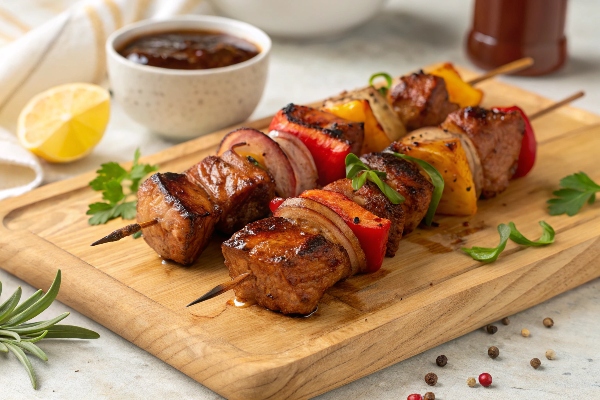
Brochettes are grilled meat skewers that embody the festive spirit of moroccan food. My earliest recollection of these succulent bites involves a local street vendor, where sizzling cubes of spiced lamb filled the air with an irresistible aroma. That first taste—tender, smoky, and kissed by cumin—was unforgettable. Brochettes are more than just barbecue; they encapsulate the nation’s flair for transformative seasoning. Gathering around an open grill, chatting with neighbors, and relishing each seared morsel becomes a highlight of any convivial occasion.
Whether fashioned from lamb, beef, or moroccan chicken, Brochettes rank high on the list of best moroccan food. The marinade—often a mix of paprika, garlic, cumin, and olive oil—seeps into the meat, infusing every cube with zesty brightness. Grilling over charcoal enhances the smoky depth, creating a mouthwatering balance of char and spice. Served hot off the flames with fresh bread or salad, Brochettes offer a joyful way to sample Morocco’s mastery of open-fire cooking and communal dining.
Level of Preparation: Easy-Moderate
Ingredients & Method: Chunks of meat or poultry, paprika, cumin, garlic, olive oil. Marinate, then skewer and grill.
Average Calories: ~350 per serving
Techniques: Marinating, grilling over charcoal
Budget: Moderate
Msemen
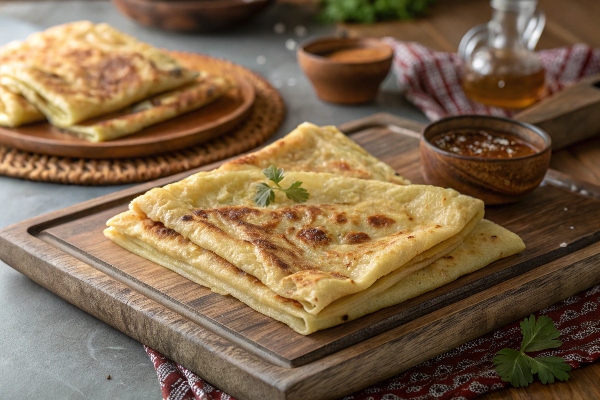
Msemen is a layered flatbread that pairs beautifully with everything in moroccan food—from sweet jams to savory stews. My first taste of Msemen was in a roadside café, served with honey and a steaming glass of mint tea. The bread’s crispy exterior gave way to soft, buttery layers inside, unraveling in my mouth like ribbons of dough. Each bite felt like a comforting embrace, reminding me that Moroccan cuisine is as much about texture as it is about taste.
This versatile bread can accompany hearty dishes like chicken tagine or succulent moroccan chicken, soaking up the aromatic sauces with its delicate folds. Skillfully created by folding and flattening the dough multiple times, Msemen takes on a buttery, flaky character reminiscent of puff pastry. Enjoy it for breakfast with melted butter and honey, or serve it alongside a savory meal to showcase its adaptability. Either way, its golden layers and comforting aroma are sure to leave a lasting impression.
Level of Preparation: Moderate
Ingredients & Method: Flour, semolina, yeast, butter, salt. Knead, fold, and flatten dough repeatedly, then cook on a griddle.
Average Calories: ~250 per piece
Techniques: Repetitive folding, careful grilling
Budget: Low
Rfissa
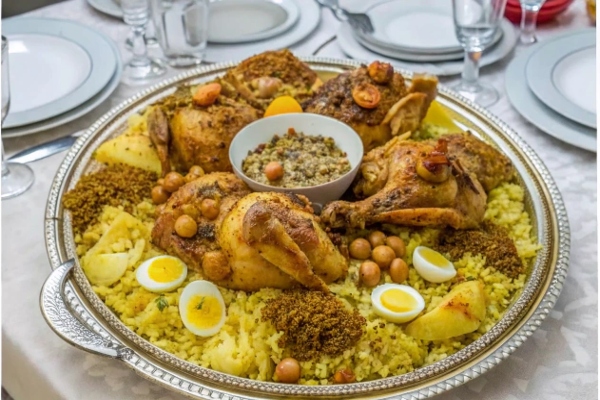
Rfissa is a comforting chicken-and-lentil dish often served during special gatherings, earning its place among the best moroccan food experiences. My introduction to Rfissa was at a family celebration marking the birth of a new baby, where the aroma of fenugreek and slow-cooked chicken embraced me like a warm hug. Thin layers of bread (traditionally msemen or trid) soaked up the spiced broth, creating a comforting, homey meal. It symbolizes warmth, nourishment, and the deep familial bonds woven into Moroccan traditions.
While it differs from a classic moroccan chicken tagine, Rfissa shares the same soul-soothing qualities often found in any cherished chicken tagine recipe. The broth is infused with onions, lentils, and fenugreek seeds, yielding a fragrant base that seeps into the shredded bread layers. Each forkful captures a medley of textures—tender chicken, silky bread, and aromatic broth. If you crave the heartwarming comforts of home-cooked fare, Rfissa stands as a testament to Morocco’s ability to turn simple staples into culinary treasures.
Level of Preparation: Moderate-Hard
Ingredients & Method: Chicken, lentils, fenugreek, onions, layered bread. Simmer chicken with spices, cook lentils, then serve over torn bread.
Average Calories: ~450 per serving
Techniques: Slow simmer, layering
Budget: Moderate
Makouda
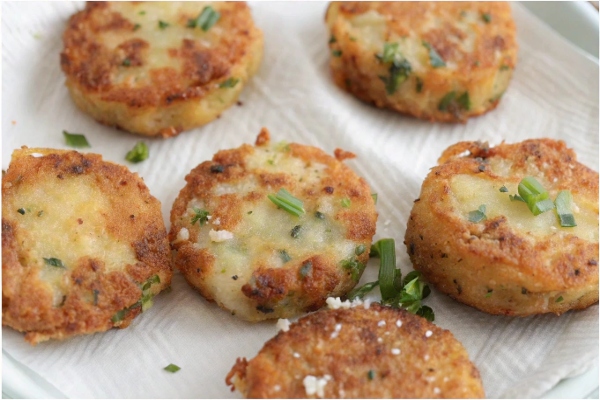
Makouda are crispy potato fritters that reveal yet another playful facet of moroccan food. I first encountered these golden delights in a crowded medina, where street vendors skillfully shaped mashed potatoes into small patties, frying them until perfectly crisp. The addictive crunch and soft center were complemented by a sprinkle of salt and a hint of cumin, a simple combination that felt surprisingly indulgent. Whether enjoyed as a snack or side dish, Makouda embodies the casual, yet flavorful side of Moroccan cuisine.
Though they lack the hearty complexity of moroccan chicken or vegetable tagine, Makouda boasts a gratifying simplicity that’s just as memorable. The potatoes are boiled, mashed, and seasoned, then formed into patties before taking a sizzling bath in hot oil. Dipped in spicy harissa or garlic sauce, these fritters can surprise your palate with bursts of warmth and creaminess. If you’re seeking a quick bite that captures the everyday charm of street food, Makouda is an essential delight to sample.
Level of Preparation: Easy
Ingredients & Method: Potatoes, cumin, salt, oil for frying. Boil, mash, shape, and fry until golden.
Average Calories: ~200 per fritter
Techniques: Seasoning, shallow or deep frying
Budget: Low
Moroccan Mint Tea
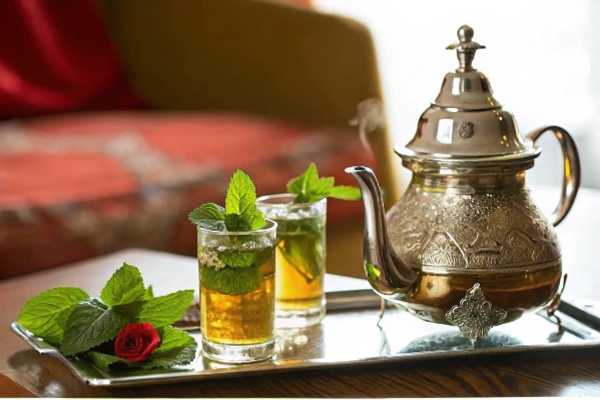
Moroccan Mint Tea is the timeless beverage that unites families and guests in a moment of sweet serenity. My first sip came from an ornate silver teapot, poured high to create a light froth in a delicate glass. The fusion of fresh spearmint, green tea leaves, and sugar creates a soothing sweetness laced with herbal complexity. This tea isn’t just a drink; it’s a symbol of hospitality, served at every social gathering to signal warmth, openness, and an invitation to linger.
Often paired with pastries or after savoring the best moroccan food, Moroccan Mint Tea also serves as a palate cleanser—perfect for following a hearty chicken tagine recipe. The ritualistic preparation involves rinsing the tea leaves, layering sugar and mint, then steeping to achieve a balanced flavor. The careful pour from a height cools the tea slightly, releasing the mint’s aromatic oils and creating its characteristic foam. Whether morning or evening, this fragrant brew delivers both refreshment and a calming embrace.
Level of Preparation: Easy
Ingredients & Method: Chinese gunpowder green tea, fresh mint, sugar, boiling water. Rinse leaves, add mint and sugar, then steep.
Average Calories: ~30 per cup (with sugar)
Techniques: Layering mint, high pour
Budget: Low
Chebakia
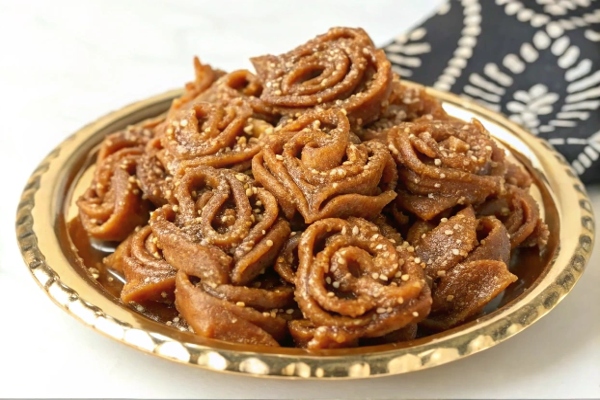
Chebakia is a sweet sesame cookie molded into intricate flower-like shapes, then fried and dipped in honey. My first taste was during Ramadan when my aunt brought out a plate of these glistening treats to break our fast. The moment I bit in, the crispy dough yielded to the sticky sweetness, unveiling hints of orange blossom water and toasted sesame. It’s a dessert that feels celebratory, a small yet luxurious pleasure that pairs beautifully with a steaming cup of mint tea.
Among the array of moroccan food desserts, Chebakia stands out for its indulgent texture and layered flavors. The dough is spiced with anise, cinnamon, and a touch of saffron, adding a subtle depth that lingers after each bite. Once shaped and fried, the pastries are immersed in warm honey, allowing every crevice to fill with syrupy delight. Served during holidays or given as gifts, Chebakia remains a treasured confection that reflects Morocco’s affection for sweet, comforting traditions.
Level of Preparation: Moderate-Hard
Ingredients & Method: Flour, sesame seeds, anise, cinnamon, honey. Knead dough, shape into intricate designs, fry, then soak in honey.
Average Calories: ~120 per piece
Techniques: Shaping, hot honey soak
Budget: Low-Moderate
Conclusion
In this journey through Morocco’s diverse culinary landscape, we’ve uncovered recipes that span vibrant salads, hearty soups, delicate pastries, and richly layered stews. Each dish celebrates a mosaic of flavors—sweet, savory, earthy, and bright—that comes alive through carefully chosen spices and time-honored traditions. Whether you find yourself savoring a simple bowl of Harira or diving into the grandeur of a moroccan chicken tagine, the warmth and generosity inherent in Moroccan cooking shine through.
With its artistry of slow braising, intricate layering, and communal sharing, Morocco has solidified its status as a gastronomic paradise. It’s no coincidence that many people consider it among the best moroccan food destinations worldwide. Each bite invites you to linger a bit longer at the table, forging connections that go beyond food itself. So immerse yourself in the textures, fragrances, and stories behind these iconic meals, and discover how Morocco’s culinary legacy remains an unforgettable feast for every sense.
If Morocco’s cuisine has captivated your senses, wait until you experience its breathtaking landscapes and vibrant culture. From bustling souks and ancient medinas to the golden dunes of the Sahara, every corner of this country tells a story. Discover the 11 Spellbinding Places to Visit in Morocco: Uncover the Best Destinations and Hidden Gems and embark on an unforgettable journey through this mesmerizing land.
What makes Moroccan food unique compared to other cuisines?
Moroccan food stands out due to its masterful use of spices, slow-cooked techniques, and fusion of sweet and savory flavors. The cuisine blends Arab, Berber, Mediterranean, and Andalusian influences, creating a diverse and deeply aromatic culinary experience. Traditional dishes like chicken tagine, lamb tagine, and pastilla highlight Morocco’s intricate spice blends, while fresh herbs and preserved lemons add depth. The communal style of eating, where meals are often shared from a large dish, further enhances its unique charm.
What are the must-try dishes for someone new to Moroccan food?
If you’re new to Moroccan cuisine, start with these essentials:
– Chicken Tagine – A slow-cooked stew of chicken, preserved lemon, and olives.
– Moroccan Couscous – Steamed semolina grains served with vegetables and meat.
– Harira – A hearty lentil and tomato-based soup.
– Pastilla – A crispy, sweet-and-savory pastry filled with spiced chicken and almonds.
– Moroccan Mint Tea – A fragrant green tea infused with fresh mint and sugar.
Each dish captures Morocco’s vibrant flavors and showcases its rich culinary traditions.
Is Moroccan food spicy?
Moroccan food is flavorful but not overwhelmingly spicy. While spices like cumin, paprika, cinnamon, ginger, and saffron are frequently used, they are more about enhancing depth rather than heat. Some dishes may include mild heat from harissa (a North African chili paste), but overall, Moroccan cuisine focuses on well-balanced, aromatic seasonings rather than intense spiciness.
Is Moroccan food suitable for vegetarians and vegans?
Yes! While Moroccan cuisine is famous for its slow-cooked meat dishes, it also offers plenty of vegetarian and vegan-friendly options.
– Vegetable Tagine – A stew of seasonal vegetables cooked in a fragrant sauce.
– Zaalouk – A smoky eggplant and tomato dip.
– Taktouka – A refreshing mix of roasted peppers and tomatoes.
– Lentil and Chickpea Harira – A meat-free variation of the classic soup.
– Msemen – Flaky Moroccan flatbread that can be enjoyed with olive oil or jam.
Many dishes are naturally plant-based or can be easily adapted by omitting meat.
What is traditionally served with Moroccan food?
Moroccan meals are often accompanied by a selection of side dishes and condiments, including:
–Khobz – Traditional Moroccan bread, perfect for scooping up tagines and dips.
–Olives – Often marinated with herbs and citrus.
–Pickled Vegetables – A tangy contrast to richer dishes.
–Moroccan Mint Tea – Served at the end of meals for digestion and refreshment.
–Harissa – A mildly spicy chili paste for those who enjoy extra heat.
Meals are typically enjoyed family-style, reinforcing the Moroccan tradition of hospitality and communal dining.


